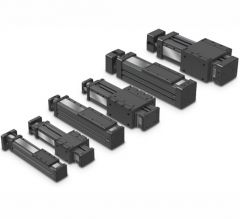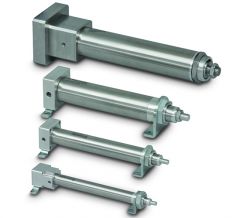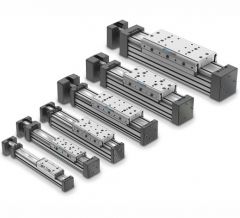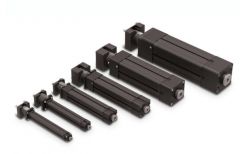Linear Actuators
Linear actuators are part of a motion control system that produces the desired motion. An actuator is a device that creates physical movement by converting various forms of energy to rotary or linear mechanical motion. A linear motion actuator is defined as a device that converts various forms of energy into linear motion or straight push/pull movements. Actuators (electric cylinders) are mainly thrust producing devices that use either an acme or ball screw as the driving mechanism.
Electromate supplies a range of linear actuators, including rodless and rod style actuators for servo and stepper motion control. We stock products from top manufacturers like Tolomatic, E-DRIVE, and Dyadic Systems. Each model has unique capabilities and applications to suit your needs. Browse through our selection of linear actuators via the category links below.
Linear Actuators we Carry
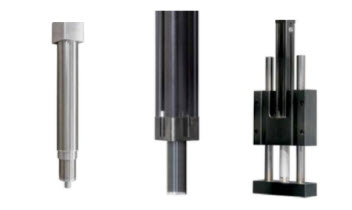

Rod Actuators
Rod type actuators produce more force and are highly tolerant of dirty environments, although they require a bearing structure to carry the load. The thrust element or rod moves out of the end of the actuator as motion takes place.
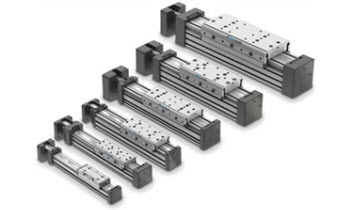

Rodless Actuators
In this actuator, the actuator housing completely surrounds the screw, which provides a load bearing and guidance structure. Rodless actuators carry the load without the need for external guides and are particularly suited for transporting loads at long stroke lengths. Rodless actuators are difficult to seal and thus are not ideal for dirty or wet environments.
Other Types of Actuators
Screw Actuators
There are several different types of screw actuators including lead screw actuators, ball screw actuators, and planetary roller screw actuators.
Lead Screw Actuator
Lead screw actuators have a threaded nut that moves with a screw, providing both simple construction and lowest cost. This type of actuator is mainly used when an industry needs a cost-effective solution. Lead screw actuators are quiet, flexible, corrosion-resistant, and have some self-locking capabilities.
Ball Screw Actuator
Ball screw actuators are essentially lead screw actuators that use ball bearings. They are usually chosen due to their faster rates of speed with continuous duty cycles and ability to carry higher loads. They are more expensive but offer less friction when compared to lead screw actuators.
Planetary Roller Screw Actuator
行星辊螺旋丝杠ac驱动器tuators that use threaded rollers surrounding the main threaded shaft. This actuator is the most expensive option, but also the most durable. Because their load-carrying rollers don’t contact each other, planetary roller screw actuators typically achieve higher speeds than ball screws.
Belt Actuators
Belt actuators are actuators based on belt drives and are often used where speed is important but with limited accuracy. These actuators operate under the same principle as the conveyor belt system; the belt drive translates rotary motion to linear motion via a timing belt. Belt actuators are designed for high speeds with long distances and are perfect for fast positioning and handling tasks
Integrated Actuators
Integrated actuators, as the name suggests, integrate a rod style actuator into a motor housing to eliminate the need for coupling. These actuators provide the lowest size and weight with easier maintenance, but at a higher cost.
Industries & Applications
What is a linear actuator used for? They are ideally suited for applications where tilting, lifting, pulling, or pushing with pounds of force are required. Common applications for linear actuators include:
- Material Handling
- Robotics
- Food and Beverage Manufacturing
- Agricultural Machinery
- Cutting Equipment
Frequently Asked Questions
What is a linear actuator?
A linear actuator is defined as a device that converts various forms of energy into linear motion or straight push/pull movements. Actuators (electric cylinders) are mainly thrust producing devices that use either an acme or ball screw as the driving mechanism. Linear actuators allow the device to slide, tilt, and lift as needed.
How do linear actuators work?
Electric linear actuators use electrical energy to enable movements in a straight line. A piston or rod moves back and forth based on control signals. Linear actuators use a motor that generates high-speed rotational motion and a gearbox that slows its impact. This increases the torque used to turn a lead screw, which results in linear motion of a shaft or drive nut. A 12V DC motor is often used in linear actuators but other motors can also be used. Switching the polarity of the connection from motor to the battery would make the motor rotate in the reverse direction.
Why use a linear actuator?
Electric linear actuators increase efficiency and enable safe, secure, and precise motion.
How do I choose a linear actuator?
When choosing a linear actuator, follow these steps:
- Determine the amount of force needed
- Determine the distance the actuator must travel
- Determine the speed
- Choose a type of linear actuator based on your specific project specifications and requirements

